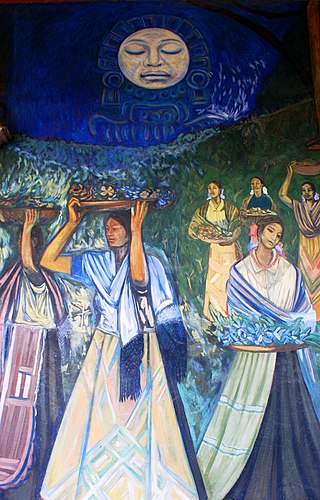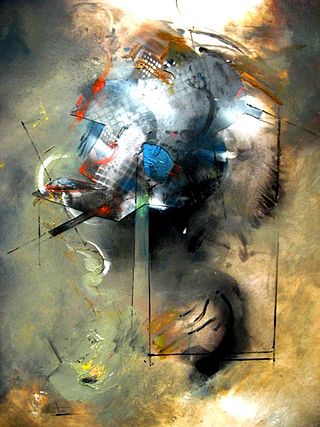
Arturo García Bustos was a Mexican painter and print maker. He is known as one of “Los Fridos” students who studied under Frida Kahlo at her home in Coyoacán.

Louis Henri Jean Charlot was a French-born American painter and illustrator, active mainly in Mexico and the United States.
José Raúl Anguiano Valadez was a notable Mexican painter of the 20th century, part of the “second generation” of Mexican muralists which continued the tradition of Diego Rivera, José Clemente Orozco and David Alfaro Siqueiros but experimented with it as well. Anguiano was born during the height of the Mexican Revolution, which would inspire a majority of his mural painting. He studied painting in his hometown of Guadalajara before moving to Mexico City to begin his career. His first major exhibition was held at the Palacio de Bellas Artes, at age 20. His works include over 100 individual and collective exhibitions with 50 murals, mostly in Mexico and the United States. As he continued his artistry with aspects of the Mexican muralism movement, he also experimented with other styles such as Cubism, Surrealism and Expressionism, with themes such as clowns and prostitutes. However, his most famous painting is “La espina” which depicts a Mayan woman digging a thorn out of her foot with a knife. His later works concentrated on depicting Mexico in vivid colors and traditional imagery.

Fernando Castro Pacheco was a Mexican painter, engraver, illustrator, printmaker and teacher. As well as being known for traditional artistic forms, Castro Pacheco illustrated several children’s books and produced works in sculpture. He is more popularly known for his murals that invoke the spirit and history of the Mexican people. His works evoke a unique use of color and form.
The Taller de Gráfica Popular is an artist's print collective founded in Mexico in 1937 by artists Leopoldo Méndez, Pablo O'Higgins, and Luis Arenal. The collective was primarily concerned with using art to advance revolutionary social causes. The print shop became a base of political activity and abundant artistic output, and attracted many foreign artists as collaborators.

José Chávez Morado was a Mexican artist who was associated with the Mexican muralism movement of the 20th century. His generation followed that of Diego Rivera, José Clemente Orozco and David Alfaro Siqueiros. Although Chávez Morado took classes in California and Mexico, he is considered to be mostly self-taught. He experimented with various materials, and was an early user of Italian mosaic in monumental works. His major works include murals at the Ciudad Universitaria, Secretaría de Comunicaciones y Transportes and Museo Nacional de Antropología in Mexico City as well as frescos at the Alhóndiga de Granaditas, which took twelve years to paint. From the 1940s on, he also worked as a cultural promoter, establishing a number of cultural institutions especially in his home state of Guanajuato including the Museo de Arte Olga Costa - José Chávez Morado, named after himself and his wife, artist Olga Costa.

Mexican Muralism refers to an art project funded by the Mexican government in an attempt to reunify the country under the government post-Mexican Revolution. The project was to allow artists to promote political ideas regarding the social revolution that had just recently ended so that viewers may reflect on how pivotal the revolution was in Mexican history. This was accomplished by way of painting murals, large artworks painted onto the wall itself, containing general social and political messages. Beginning in the 1920s, the muralist project was headed by a group of artists known as "The Big Three" or "The Three Greats". This group was composed of Diego Rivera, José Clemente Orozco and David Alfaro Siqueiros. From the 1920s to the 1970s, many murals with nationalistic, social and political messages were created in many public settings such as chapels, schools, government buildings, and much more. The popularity of the Mexican muralist project started a tradition which continues to this day in Mexico; a tradition that has had a significant impact in other parts of the Americas, including the United States, where it served as inspiration for the Chicano art movement.
Fanny Rabel, born Fanny Rabinovich, was a Polish-born Mexican artist who is considered to be the first modern female muralist and one of the youngest associated with the Mexican muralism of the early to mid 20th century. She and her family arrived to Mexico in 1938 from Europe and she studied art at the Escuela Nacional de Pintura, Escultura y Grabado "La Esmeralda", where she met and became friends with Frida Kahlo. She became the only female member of “Los Fridos” a group of students under Kahlo’s tutelage. She also worked as an assistant and apprentice to Diego Rivera and David Alfaro Siqueiros, painting a number of murals of her own during her career. The most significant of these is "Ronda en el tiempo" at the Museo Nacional de Antropología in Mexico City. She also created canvases and other works, with children often featured in her work, and was one of the first of her generation to work with ecological themes in a series of works begun in 1979.
"Abel" Antonio Pujol Jiménez was a Mexican painter and printmaker.

The Abelardo L. Rodriguez Market is a traditional public market located in the historic center of Mexico City, northeast of the main plaza, or Zocalo. It was built in 1934 as a prototype for a more modern marketplace and has a number of unusual features such as day care and an auditorium. However, the market's most distinctive feature is the approximately 1,450 square metres of wall and ceiling space covered in murals. These murals were painted by muralists, some former Diego Rivera helpers. Rivera had a role in approving artist designs, but little else. The works mostly reflect socialist themes, such as the exploitation of workers, peasants and miners, the fight against Nazism and fascism, and racial discrimination. Earthquakes, time, humidity and vandalism took their toll on the murals from the time they were painted until restoration began in January 2009. Restoration work is expected to take almost two years.
Ignacio Aguirre was a Mexican painter and engraver.
Francisco Mora was a Mexican artist of the "Mexican School" of mural painters.

Alfredo Zalce Torres was a Mexican artist and contemporary of Diego Rivera, David Siqueiros and other better-known muralists. He worked principally as a painter, sculptor, and engraver, also taught, and was involved in the foundation of a number of institutions of culture and education. He is perhaps best known for his mural painting, typically imbued with "fervent social criticism". He is acclaimed as the first artist to borrow the traditional material of coloured cement as the medium for a "modern work of art". Publicity-shy, he is said to have turned down Mexico's Premio Nacional de Ciencias y Artes before finally accepting it in 2001. Before his death, Sotheby's described him as "the most important living Mexican artist up to date".
Ángel Bracho was a Mexican engraver and painter who is best known for his politically themed work associated with the Taller de Gráfica Popular; however he painted a number of notable murals as well. Bracho was from a lower-class family and worked a number of menial jobs before taking night classes for workers at the Escuela Nacional de Artes Plásticas. Even though he had only four years of primary school, he then studied as a full-time student at the university. His art career began working with Diego Rivera on the painting of the Abelardo L. Rodríguez market in Mexico City. He was a founding member of the Taller de Gráfica Popular, making posters that would become characteristic of the group. His graphic design work is simple, clean and fine dealing with themes related to social struggles with farm workers, laborers and Mexican landscapes.

Leopoldo Méndez was one of Mexico's most important graphic artists and one of that country's most important artists from the 20th century. Méndez's work mostly focused on engraving for illustrations and other print work generally connected to his political and social activism. His most influential work was connected to organizations such as the Liga de Escritores y Artistas Revolucionarios and the Taller de Gráfica Popular creating propaganda related to the ideals of the Mexican Revolution and against the rise of Fascism in the 1930s. Despite his importance in 20th-century artistic and political circles, Méndez was a relatively obscure figure during his life, and remains so afterwards. The reasons for this generally relate to the fact that he believed in working collaboratively and anonymously for the good of society rather than for monetary gain and because the socialist and communist themes of his work fell out of favor with later generations. Despite this, he has received some posthumous recognition with Mexican scholarship considering him to be the successor to graphics artist José Guadalupe Posada.
Abelardo Ávila Villareal (1907-1967) was a Mexican engraver noted for his Costumbrista work, mostly with the Sociedad Mexicana de Grabadores; however, he did paint one mural along with Pedro Rendón at the Abelardo L. Rodríguez market in Mexico City.

Adolfo Mexiac was a Mexican graphic artist, known principally for his politically and socially themed work, especially with the Taller de Gráfica Popular and with fellow graphic artist Leopoldo Méndez. He also painted several murals, the most important of which deals with the history of human law at the University of Colima. In 2011, a “national homage” was held for the artist at the Museo de la Estampa in Mexico City.

Generación de la Ruptura is the name given by art critic Teresa del Conde to the generation of Mexican artists against the established Mexican School of Painting, more commonly called Mexican muralism post World War II. It began with the criticisms of José Luis Cuevas in the early 1950s, followed by others who thought the established art had become dogmatic, formulaic and nationalistic and the artists too deferential to the government. This new generation of artists was not bound by a particular artistic style but was more interested in personal rather than social issues and influenced by a number of international trends in art such as Abstract expressionism. Early reaction to them was strong and negative but by the end of the 1950s, they had succeeded in having their art shown in the major venues of Mexico. The Generación de la Ruptura had influence on other arts in Mexico, such as literature but it did not end the production of murals in Mexico with social and nationalist purposes.
Jesús Álvarez Amaya was a Mexican painter and graphic artist, mostly known for mural work and his graphic work as head of the Taller de Gráfica Popular, which he led from 1967 until his death. His murals can be found in various parts of the country and his art mostly have social and political themes.

José Hernández Delgadillo was a Mexican painter and muralist best known for carrying on the traditions of Mexican muralism in the latter 20th century. He created over 160 murals in Mexico and the United States, with most of his work, especially after 1970, containing strong political messages. Many of these messages have been unpopular in Mexico, which has made the artist somewhat obscure and some of his murals have been destroyed. Hernández Delgadillo's main recognition is membership in the Salón de la Plástica Mexicana honor society, but his home state has made effort to rescue and promote his life and work.












